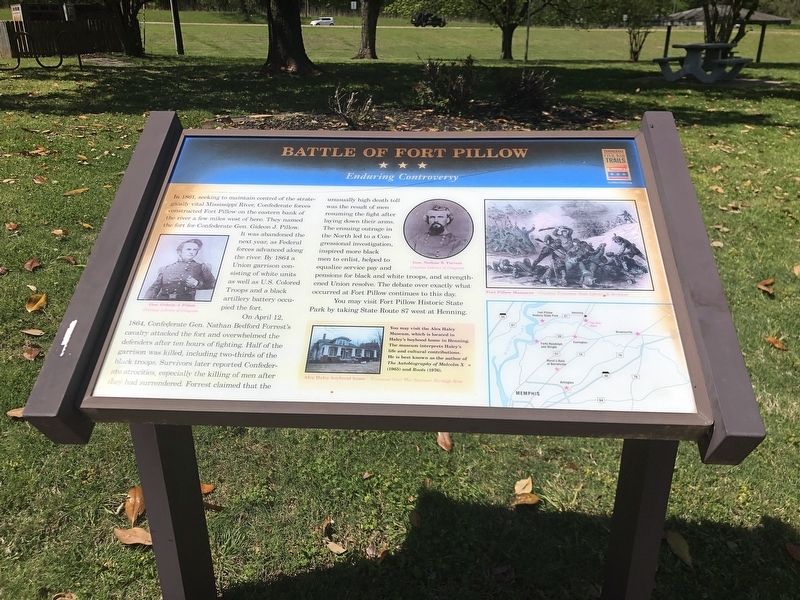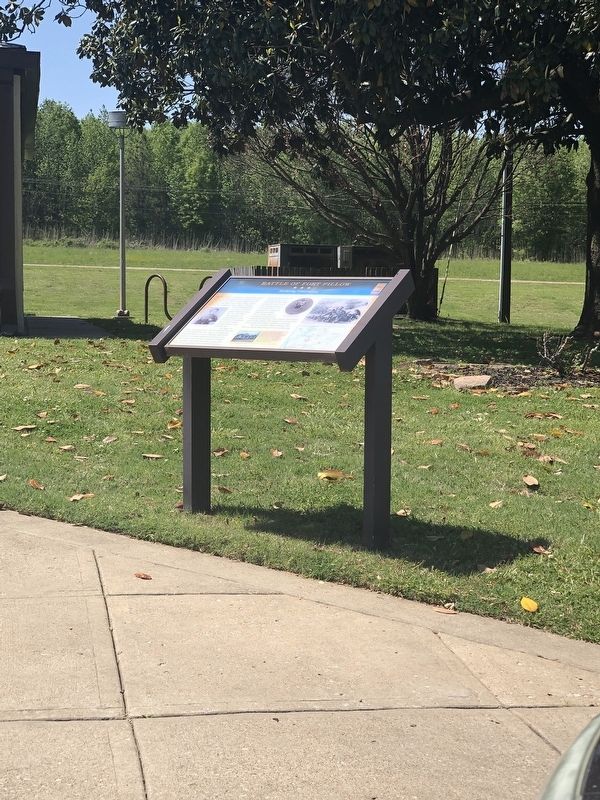Near Henning in Lauderdale County, Tennessee — The American South (East South Central)
Battle of Fort Pillow
Enduring Controversy
On April 12, 1864, Confederate Gen. Nathan Bedford Forrest's cavalry attacked the fort and overwhelmed the defenders after ten hours of fighting. Half of the garrison was killed, including two-thirds of the black troops. Survivors later reported Confederate atrocities, especially the killing of men after they had surrendered. Forrest claimed that the unusually high death toll was the result of men resuming the fight after laying down their arms. The ensuing outrage in the North led to a Congressional investigation, inspired more black men to enlist, helped to equalize service pay and pensions for black and white troops, and strengthened Union resolve. The debate over exactly what occurred at Fort Pillow continues to this day.
You may visit Port Pillow Historic State Park by taking State Route 87 west at Henning.
[Captions (Clockwise from left)]
• Gen. Gideon J. Pillow Courtesy Library of Congress
• Gen. Nathan B. Forrest Courtesy Library of Congress
• Fort Pillow Massacre Courtesy Tennessee State Library & Archives
• Alex Haley boyhood home
You may visit the Alex Haley Museum, which is located in Haley's boyhood home in Henning. The museum interprets Haley's life and cultural contributions. He is best known as the author of The Autobiography of Malcolm X (1965) and Roots (1976).
Erected by Tennessee Civil War Trails.
Topics and series. This historical marker is listed in these topic lists: African Americans • War, US Civil. In addition, it is included in the Tennessee Civil War Trails series list. A significant historical date for this entry is April 12, 1864.
Location. 35° 39.229′ N, 89° 35.772′ W. Marker is near Henning, Tennessee, in Lauderdale County. Marker can be reached from U.S. 51 south of Lovelace Crossing Road. Marker is in the U.S. 51 Lauderdale County Rest Area on the northbound side. Touch for map. Marker is at or near this postal address: 7344 US-51, Henning TN 38041, United States of America. Touch for directions.
Other nearby markers. At least 8 other markers are within 7 miles of this marker, measured as the crow flies. Alex Haley's Boyhood Home (approx. 1.8 miles away); Fort Pillow (approx. 1.8 miles away); Canaan Missionary Baptist Church History (approx. 6.7 miles away); Isaac Hayes (approx. 6.8 miles away); Hotel Lindo (approx. 6.8 miles away); Tipton County in the Civil War (approx. 6.8 miles away); Tipton County Confederate Monument (approx. 6.8 miles away); Frances Boyd Calhoun (approx. 6.8 miles away). Touch for a list and map of all markers in Henning.
Also see . . .
1. The Fort Pillow Massacre: A Statistical Note (PDF). A statistical analysis of Civil War military records lend credence to reports of a massacre of African-American Union soldiers at Fort Pillow. (John Cimprich and Robert C. Mainfort, Jr., The Journal of American History, 1989) (Submitted on May 1, 2023, by Duane and Tracy Marsteller of Murfreesboro, Tennessee.)
2. Fort Pillow Massacre. The Fort Pillow Massacre in Tennessee on April 12, 1864, in which some 300 African American soldiers were killed, was one of the most controversial events of the American Civil War (1861-65). Though most of the Union garrison surrendered, and thus should have been taken as prisoners of war, the soldiers were killed. The Confederate refusal to treat these troops as traditional prisoners of war infuriated the North, and led to the Union’s refusal to participate in prisoner exchanges. (History Channel) (Submitted on May 1, 2023, by Duane and Tracy Marsteller of Murfreesboro, Tennessee.)
Credits. This page was last revised on May 1, 2023. It was originally submitted on May 1, 2023, by Duane and Tracy Marsteller of Murfreesboro, Tennessee. This page has been viewed 103 times since then and 18 times this year. Photos: 1, 2. submitted on May 1, 2023, by Duane and Tracy Marsteller of Murfreesboro, Tennessee.

